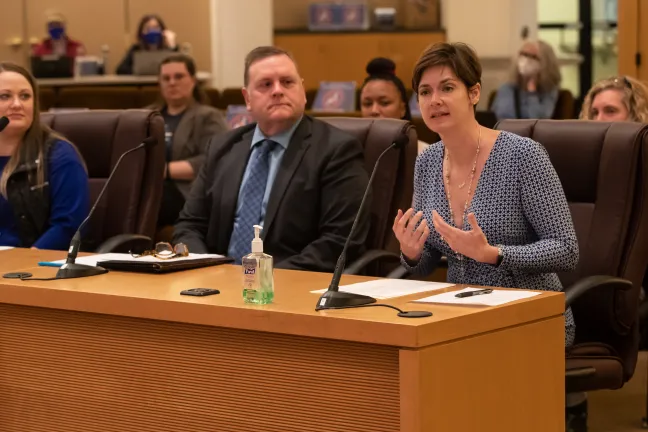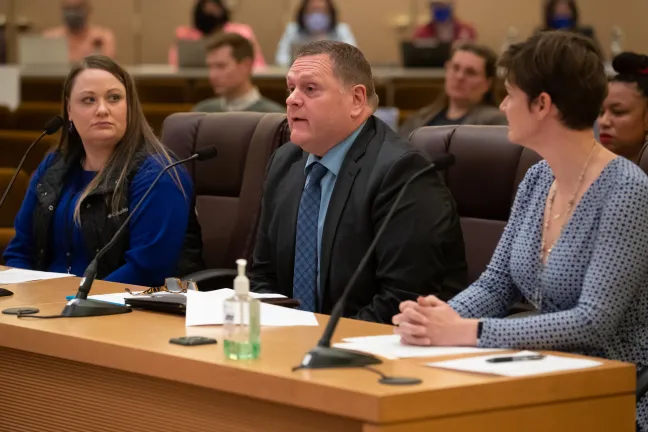The Multnomah County Board of Commissioners proclaimed April 2022 as Child Abuse Prevention Month, recognizing the importance of prevention, collaboration and support to help families thrive, and ultimately, to protect children from abuse and neglect.
Across the nation, the month of April serves as an opportunity to spread the word about child abuse prevention and the multidisciplinary responses that are critical to address it.
In Multnomah County, a Multi-Disciplinary Child Abuse Team, mandated by law and coordinated through the Multnomah County District Attorney’s Office, works to ensure each child abuse incident is addressed adequately. That team includes representatives from CARES NW, law enforcement, public schools, hospitals, courts, health departments, the Oregon Department of Human Services (DHS), and the Oregon Department of Employment Child Care Division.
“We’re all responsible for different aspects,” said Jenny Gilmore-Robinson, executive director of Cares NW, a community-based medical program, as she opened Thursday’s proclamation. “And we work together to form a much stronger and cohesive whole.”
Three members of Multnomah County’s multidisciplinary team presented to the Board. Tom Cleary, a senior deputy district attorney with 30 years as a Multnomah County prosecutor, spent most of his career protecting children and working with families.
“The secret to its success is collaboration,” Cleary said of the County’s team.
“The more information and the quicker we can get that information, the better decisions we can make for the safety of these children and their families — working hard in both the criminal courts but also the dependency courts, which are specialty areas of law, to work towards reuniting families in a healthy and safe way.”
The impacts of COVID-19 — from physical distancing to communications issues to access to court services — have interrupted normal operations. But as endangered children return to places where they can encounter trusted adults and mandatory reporters, the team’s work will pick up, said Cleary.
“We’re working hard to develop experienced prosecutors to develop a passion for this type of work, so they can join us as we have turnover in the office,’’ said Cleary.
“And we’re grateful to work with CARES, Oregon Department of Human Services, our law enforcement partners, our children’s attorneys, our parents’ attorneys as we put together these plans for the children.”
Oregon Department of Human Services
Lisa Bender, a program manager for Oregon’s Department of Human Services’ Gateway branch, said the department recently rolled out a “Child Welfare Vision for Transformation” that centers equity as a north star. The vision includes supporting families, promoting prevention, enhancing staff and infrastructure, and enhancing the use of data.
“We’re looking at how we’re using that data – exploring what our problems are, where our gaps are and where our strengths are.”
One such strength is the state department’s Family Preservation Pilot, an initiative that supports families through cooperative agreements to maintain children’s safety at home, without court intervention, by bolstering uniquely tailored, in-home services. A demonstration site launched last month in Northeast Portland’s Alberta neighborhood, Bender said.
The Family Involvement Team (FIT), a collaboration with Multnomah County’s Department of County Human Services, the Health Department’s Behavioral Health Division, local drug and alcohol and treatment providers, and more, has also expanded to work with recovery navigators to support families struggling with substance use disorders.
And finally, new partnerships were forged to cross-train staff so they can also work with families with children who have intellectual and developmental disabilities.
The Oregon Department of Human Services, like so many agencies in the field, continues to face challenges in workforce shortages, said Bender.
“There were surges of calls to ODHS’ child abuse hotline last fall and an accompanying rise in wait time,” she said. “But we got together with our team to develop strategies to improve that. And since December, call times have been down.”
CARES NW
Jenny Gilmore Robinson's career includes over two decades in child welfare.
“Even after all this time, what hurts my heart about child abuse is how seemingly hidden it stays,” she said. “Yet it’s happening every day, in every neighborhood, in every ZIP code. But it seems to be invisible unless we’re actively looking for it.”
While clinic appointments stayed the same as the previous year, there were a high number of no-shows and cancellations, primarily because of illness and other barriers, she said. CARES NW has recorded:
- A 10 percent increase in requests for trauma-focused therapy sessions and an increased demand for family support services.
- Intake cases, which are typically the most severe, increased by 22 percent.
- Other struggles accompanied all cases, including poverty, parental substance use, houselessness, racial oppression and other generational trauma.
According to the proclamation and the state’s Child Welfare Data Book, Oregon saw 78,632 reports of child abuse and neglect in 2020.
Multnomah County saw 12,902 reports of abuse and neglect. The leading stress factor when child abuse was present in a family was substance abuse by a parent/caregiver. The next most common stress factor was domestic violence.
“I can’t tell you if child abuse has increased during COVID. No one really can, at this point,” said Robinson. “But I will tell you anecdotally the cases have been so severe, it’s breathtaking. Head trauma, ingestion of substances, even torture cases.”
The ripple effects are felt by staff, and they are compounded by COVID fatigue, even gun violence that’s happening right outside the doors of our clinic, as recently as this past Tuesday, said Robinson.
“I think that’s why events like Child Abuse Prevention Month are that much more important. It requires us; it forces us to talk about things that we don’t want to think about and inspires us to take action.”
“Public health issues like child abuse are preventable; but only if our community works together. No one agency or one person can solve this problem, especially this one so complex.”
“That’s why I’m grateful to be part of CARES NW and this multidisciplinary team. We’re keeping our eyes on the ball. The most important thing in this situation is the child.”
Chair Deborah Kafoury asked about requirements for mandatory reporting and spotting incidents of abuse.
We have a standardized curriculum for mandatory reporting training, said Bender. “It’s a structured course of video presentation and question and answers. It’s an on-going thing in helping folks realize, what is child abuse; when to refer to DHS; and when maybe wrap around services are needed as opposed to a child welfare response.”
“Frankly, I don’t know how you do this work day-in and day-out, but I’m so grateful that you do,” said Commissioner Lori Stegmann. “The need is so great and all those other factors play into getting upstream.”
“When you hear that there were almost 13,000 cases in 2020 that’s staggering,” said Commissioner Jessica Vega Pederson. “It’s a huge number and it just shows the importance of raising awareness and getting the right resources into the community.”
“It is incredible and I appreciate the key being the collaboration and the multidisciplinary team,” Commissioner Sharon Meieran said. “Because that is the answer. It has to be.”
Watch the full proclamation here.

